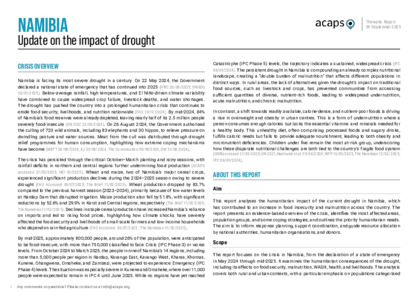Latest updates on country situation
27 October 2025
Food insecurity in Namibia is projected to increase between October 2025 and March 2026, with 612,000 people projected to face Crisis (IPC Phase 3) food insecurity from 456,000 between July–September 2025. This deterioration follows the end of drought relief coupled with persistently high unemployment and poor livestock conditions. (IPC 13/10/2025)
18 February 2025
Between 2022–2024, a total of 94 malnutrition-related deaths were reported in Ohangwena region. The country's authorities declared a drought in 2024, which has since been aggravating food insecurity and malnutrition nationwide. That year alone saw 18 malnutrition-related deaths (14 children and 4 adults). Overall, malnutrition affected 22.2% of the population in 2024, with 6.2% of children under five years of age suffering from acute malnutrition, indicating severe undernutrition, and 14.5% suffering from chronic malnutrition. From October 2024 to March 2025, an estimated 1.26 million people (41% of the analysed population) are projected to experience acute food insecurity – i.e. Crisis (IPC Phase 3) or worse levels – including 100,000 facing Emergency (IPC Phase 4) conditions. With the continuing drought and decreasing food availability because of poor harvests in the 2024–2025 agricultural season, the incidence of malnutrition and related risk of starvation may increase. (The Namibian 12/02/2025, GHI accessed 19/02/2025, IPC 06/09/2024)
24 September 2024
In 2024, southern Africa is experiencing its worst drought in 100 years as a result of El Niño. Approximately 61 million people need assistance, with over 20 million experiencing Crisis (IPC Phase 3) food insecurity levels. Botswana, Lesotho, Malawi, Namibia, Zambia, and Zimbabwe have declared a state of emergency in response to the severe drought. There has also been a significant increase in malnutrition cases in Angola, Madagascar, Malawi, Mozambique, and Zambia, with expectations for the trend to continue into the first quarter of 2025. (OCHA 20/09/2024, OCHA 19/09/2024)
13 September 2024
Between October 2024 and March 2025, approximately 1.26 million people will experience high acute food insecurity, including 100,000 facing Emergency (IPC Phase 4) conditions. The food insecurity figure marks a 45% increase compared with the 695,000 projection for the same period in the previous year. This increase is attributed to factors including the negative impact of El Niño, limited livestock pasture and water availability, limited agricultural labour opportunities, and an unfavourable health and nutrition environment. (IPC 06/09/2024, IPC 06/09/2023)
03 September 2024
In 2024, Namibia is experiencing its worst drought in 100 years, affecting food security. Nearly 50% of its three million population is experiencing high acute food insecurity, i.e. Crisis (IPC Phase 3) levels or worse. The production of cereals, including staples such as maize and millet, has declined by 53%, and dam water levels have fallen by 70% compared to 2023. 84% of the country’s food reserves have been exhausted. Food and water scarcity could push part of the 840,000 population facing Stressed (IPC Phase 2) food insecurity to higher levels. Malnutrition is already a concern in Namibia. Around 17% of the population is undernourished, and around 17% and 6% of children under five are experiencing chronic and acute malnutrition, respectively. The drought is worsening the situation among children under five, with deaths already reported in some regions. (UN DGC 23/08/2024, UN 19/07/2024, WHH/Concern Worldwide 10/2023)
09 July 2024
Between July–September 2024, an estimated 1.4 million people (48% of the analysed population) in Namibia are projected to experience high acute food insecurity levels – i.e. Crisis (IPC Phase 3) or worse – including 85,000 facing Emergency (IPC Phase 4) levels. The total is more than double the number in the same period in 2023 (579,000). The entire country, including all 14 regions, is currently classified to be facing IPC 3 levels and requires assistance for livelihood protection, as the majority of people are agropastoralists. The main factors to the deteriorating food security situation are the drought and other impacts of El Niño on crop and livestock production, inflation, the decline in economic growth, and unemployment. On 22 May, the Namibian Government declared a national state of emergency in response to the drought affecting all regions of the country. (IPC 06/09/2023, IPC 08/07/2024, Namibian 27/05/2024)
04 June 2024
On 22 May 2024, the Namibian Government announced a state of emergency in response to the most severe drought the country has seen in a century, which has affected all its 14 regions. Approximately one-fifth of Namibians (an estimated 600,000 out of a total population of three million) are struggling with food insecurity. The affected people urgently require food assistance. (Namibia Economist 28/05/2024, USAID 24/05/2024, WFP 23/05/2024)
current crises
in
Namibia
These crises have been identified through the INFORM Severity Index, a tool for measuring and comparing the severity of humanitarian crises globally.
NAM002 - Drought
Last updated 28/11/2025
Drivers
Drought/drier conditions
Crisis level
Country
Severity level
2.6 Medium
Access constraints
1.0


